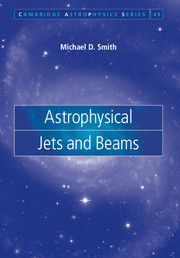Book contents
- Frontmatter
- Contents
- Preface
- 1 Introduction
- 2 Detection and measurement
- 3 The dynamical toolbox
- 4 Observations of extragalactic jets
- 5 Jets in galactic nuclei
- 6 Jets from young stars and protostars
- 7 Jets associated with evolved stars
- 8 Jets within the solar system
- 9 Jet launching
- 10 Jet propagation
- 11 The astrophysical jet
- References
- Index
4 - Observations of extragalactic jets
Published online by Cambridge University Press: 05 March 2012
- Frontmatter
- Contents
- Preface
- 1 Introduction
- 2 Detection and measurement
- 3 The dynamical toolbox
- 4 Observations of extragalactic jets
- 5 Jets in galactic nuclei
- 6 Jets from young stars and protostars
- 7 Jets associated with evolved stars
- 8 Jets within the solar system
- 9 Jet launching
- 10 Jet propagation
- 11 The astrophysical jet
- References
- Index
Summary
The largest known individual objects in the universe are carved out by extragalactic jets. These are giant radio galaxies which can have linear extents of up to several megaparsecs. It should be immediately remarked that this type of galaxy is not itself composed of stars, dark matter and an interstellar medium, but is instead created by events from within a compact engine embedded in the core of the actual galaxy. Twin jets extend from the nucleus of the galaxy to feed energy into two extended reservoirs of relativistic and magnetic energy. In common, the observed radio emission is due to the synchrotron process and the extended environments are optically thin. In contrast, the compact central radio core corresponding to the origin of the jets is optically thick, detected with a self-absorbed flat spectrum.
The study of extragalactic jets and that of radio galaxies are closely connected. The size and shape of the radio sources reveal how efficiently jets can penetrate through their host galaxy. Some radio sources are identified with or directly related to the propagating jets, while many others appear to be the subsequent overspill associated with the jets’ abrupt termination. The latter sources consist of two distinct lobes, which contain hot spots through which the energy is transferred into the lobes.
The distinctive morphologies of radio galaxies have provided the most robust means of jet classification and we begin below by reviewing the classes. Such a classification scheme is, for this book, not just a means of book-keeping.
- Type
- Chapter
- Information
- Astrophysical Jets and Beams , pp. 50 - 69Publisher: Cambridge University PressPrint publication year: 2012

